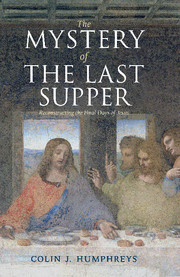Book contents
- Frontmatter
- Contents
- List of illustrations
- Foreword by I. Howard Marshall
- Acknowledgements
- 1 Four mysteries of the last week of Jesus
- 2 Dating the crucifixion – the first clues
- 3 The problem of the last supper
- 4 Can we reconstruct the Jewish calendar at the time of Christ?
- 5 The date of the crucifixion
- 6 The moon will be turned to blood
- 7 Did Jesus use the solar calendar of Qumran for his last supper Passover?
- 8 Does ancient Egypt hold a key to unlocking the problem of the last supper?
- 9 Discovering the lost calendar of ancient Israel
- 10 Was the lost ancient Jewish calendar used in Israel at the time of Jesus?
- 11 The date of the last supper: the hidden clues in the gospels
- 12 From the last supper to the crucifixion: a new analysis of the gospel accounts
- 13 A new reconstruction of the final days of Jesus
- Notes
- Bibliography
- Index of biblical and other ancient sources
- General index
5 - The date of the crucifixion
Published online by Cambridge University Press: 03 May 2011
- Frontmatter
- Contents
- List of illustrations
- Foreword by I. Howard Marshall
- Acknowledgements
- 1 Four mysteries of the last week of Jesus
- 2 Dating the crucifixion – the first clues
- 3 The problem of the last supper
- 4 Can we reconstruct the Jewish calendar at the time of Christ?
- 5 The date of the crucifixion
- 6 The moon will be turned to blood
- 7 Did Jesus use the solar calendar of Qumran for his last supper Passover?
- 8 Does ancient Egypt hold a key to unlocking the problem of the last supper?
- 9 Discovering the lost calendar of ancient Israel
- 10 Was the lost ancient Jewish calendar used in Israel at the time of Jesus?
- 11 The date of the last supper: the hidden clues in the gospels
- 12 From the last supper to the crucifixion: a new analysis of the gospel accounts
- 13 A new reconstruction of the final days of Jesus
- Notes
- Bibliography
- Index of biblical and other ancient sources
- General index
Summary
for Christ, our Passover lamb, has been sacrificed.
(1 Corinthians 5:7)But Christ has indeed been raised from the dead, the first-fruits of those who have fallen asleep.
(1 Corinthians 15:20)In the last chapter I argued that we can use astronomy to reconstruct the first-century ad Jewish calendar. In this chapter we will see if it is possible to use our reconstructed calendar, together with biblical and historical clues, to determine not only the year but also the precise day and month on which Christ died. If we know this date, this enables us to start to answer the question of whether or not the last supper was a Passover meal. In particular, in Chapter 3 we gave four possible interpretations of the gospels concerning the date and nature of the last supper. In this chapter we will show that we can reject two of these interpretations. As we will see, both biblical and non-biblical clues fit together in a most remarkable way.
DETERMINING THE DATE OF THE CRUCIFIXION
Let us start by reminding ourselves about what we already know. In Chapters 2 and 3, I showed that the crucifixion was in the period ad 26–36, it was on a Friday and it was on either Nisan 14 or 15 in the official Jewish calendar, depending on the correct interpretation of John's gospel and the synoptics. Virtually all biblical scholars agree with these three statements, and I believe they are correct, beyond reasonable doubt.
- Type
- Chapter
- Information
- The Mystery of the Last SupperReconstructing the Final Days of Jesus, pp. 61 - 79Publisher: Cambridge University PressPrint publication year: 2011

